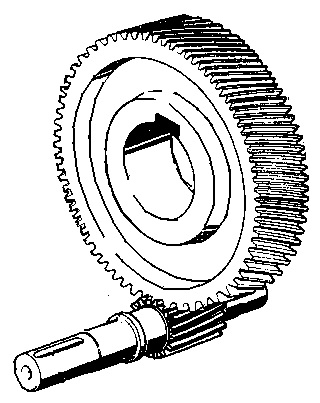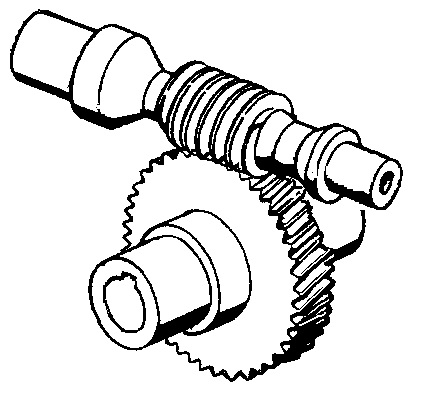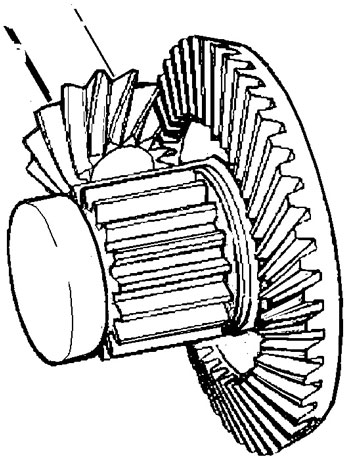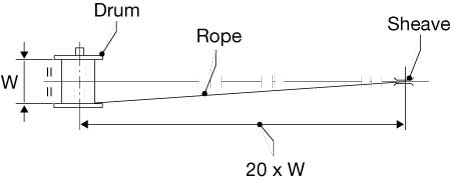Winch selection
Selecting the right type of winch
Load capacity, speed and desired rope storage are all instrumental in selecting the the type of winch. The EMCÉ winch programme is structured in such a way that often several winch types overlap each other in capacity, and the most suitable gearbox/drive combination can be selected for the application. In the section below the relative advantages of the different motive power and gearbox types are briefly explained. Primary selection criteria are intended load, rope storage and desired functionality. Some criteria can only be met by certain types of winch for example a large rope capacity most likely needs an (extended) SB or SC winch, while if a compact winch size and a more modest rope capacity is required the FD type may be the better choice. Carefully study the EMCÉ catalogue to make a rough pre-selection of possible winch types for your particular application. Make sure to filter out incompatibilities such as continuous operation with a worm gearbox, or a clutch or band brake with an FD type. In case of doubt consult the EMCÉ sales office who can assist with determining the right type of winch.
Designing the right type of winch
If your particular application or requirements cannot be covered by a "standard" winch EMCÉ offers the option of having a winch or capstan built for a particular purpose or requirement. In practice this since many EMCÉ standard winches can be customized almost beyond recognition to for fill a specific role or task. In those cases where a truly unique design or concept is required you will find the EMCÉ sales and design offices at your side to help you to overcome your challenge or to realise your ambitions. As with "standard" winches it still makes sense to
Selecting the right type of motive power
Selecting the motive power can be influenced by personal preferences, regulations, the available infrastructure or financial reasons. In the EMCÉ programme Electric, Hydraulic and Pneumatic winches and capstans are available, while also a number of manually driven winches can be supplied.
If no clear type of motive power is preferred or required, always try electric first.
Electric
Electric (brake) motors in their standard form can already be used for many winch applications. When required they can be water and dust proofed up to IP 67, made to comply with ATEX regulations, fitted with independent cooling or heating or fitted with encoders and sensors to monitor and control their operation.
Electric motors are clean and quiet, and in most places access to the main grid is no problem. The technology is widely understood, and in combination with the right control system an almost unlimited number of control and automatization options are available for a very wide power range.
Hydraulic
Hydraulic motors are the first choice when there is already a source of hydraulic power available, but on request electro- or diesel/hydraulic power packs can be supplied by EMCÉ. The motors are very compact for their power and torque capabilities, and are by virtue of their working principle dust and water proof and very sturdy and reliable. That is why hydraulic winches are often found in rugged applications both on land and on sea. Hydraulics can be noisy and require a carefully laid out piping and control infrastructure.
Pneumatic
Pneumatic motors come into their own in areas with a high explosion risk such as in the petroleum, mining and chemical/petrochemical industry. In the days ATEX electric motors were not very common, air motors were the primary means of powering equipment in hazardous areas, and to this day are still very popular for this purpose. Also their ability to cope with severe overloading or even blockage is an important advantage in some applications. Controllability is similar to hydraulics, but controllability and adaptability is not as good as with electric motors. Not unlike hydraulic motors, pneumatic motors should only be considered when an ample supply of compressed air is already available, or indeed when the operational considerations mentioned above are applicable.
Selecting the right type of gearbox
Gearbox selection depends largely on the amount of torque to be transmitted, the required efficiency and if the gearbox can be integrated easily into the winch. With some higher torque values the choice of gearbox is limited, simply while only one or two types of box are strong enough.
With low and medium torque values almost any type of gearbox is available to choose from, and picking the right one becomes more complicated. In the EMCÉ winch programme four main types of gearbox are used. a) Spur gearbox - b) Worm gearbox - c) Bevel gearbox - d) Planetary gearbox.
Each type of gearboxes has its particular advantages or disadvantages, depending on the application it must be decided which of the gearbox properties will be the most important.
Spur gear

Spur gearboxes are mostly used as stepdown gear in combination with a worm gearboxes. Efficiency is excellent, and only in very special cases this type of gearbox is used to drive a winch in its own right.
Worm gear

Worm gearboxes can be found in winches up to 2,5 tonne pulling or 1,8 tonne hoisting, for intermittent use. They can also be found as auxiliary gearboxes in spooler drives or as stepdown gear in combination with a planetary gearbox. Depending on the gear ratio the efficiency can be quite low in particularly while starting up. With gear ratios above 80:1 efficiency is such that the boxes are considered self-locking (the output shaft does not rotate under load with the input shaft being stationary) which in certain applications (winches without motor brake) can be advantageous. Pricing is competitive, and by virtue of their design, it takes only limited number of extra parts to build a winch.
Bevel gear

Bevel gearboxes combine the physical ability of the worm gearbox to provide part of the winch structure with the power and efficiency advantages of planetary gearboxes. Good efficiency, wide range of gear ratios and torque capacities can be combined with all types of motive power. In many applications the standard bevel arrangement in which the input shaft has a 90 degree angle with the output shaft and in which the output shaft is available at both sides of the gearbox which can be very practical.
Planetary gear

Planetary gearboxes form the central type of gearbox for winches of medium to high capacity. The modular design means that an almost unlimited number of gear ratios can be provided spanning a very wide torque and power range. Due to its adaptability different types of motors can be fitted, but also integral multi-disc brakes, cooling or heating systems or when required on-off special gearboxes can be provided. Efficiency and reliability are excellent be it in marine, mining or general industrial applications.
Combined types
For very large or very special winches different types of gearboxes are combined to provide the ideal transmission solution. A solution that has been used successfully many times is the combination of large diameter slew ring with an integral gear ring that is driven by multiple planetary gearboxes. In this manner very high torque values can be reached, but also the forces are more evenly distributed and depending on gearbox/drive dimensioning a very high grade of redundancy is available. The combination of large diameter bearings with an externally placed drive components also makes the inside of the drum available and accessible for large slip ring or swivel coupling installations, which makes this the ideal choice for hose and cable reels.
Selecting the right type of brake
Almost all lifting winches have a motor- or transmission brake, pulling winches usually do not have a brake. In lifting winches the need for a brake speaks for itself, the key question is not if but how much brake is required. For gentle lifting and lowering at low load and low speed the self-locking action of a worm gear box may be sufficient (where regulations permit this) but for high speed dynamic braking of high loads a substantial and dedicated braking system has to be fitted. For man riding winches an independent double system has to be fitted.
In many cases a good check on regulations and requirements in combination with the operational requirements will clarify the type and number of brakes required. Four types of brakes are used. a) motor brake, b) transmission brake, c) drum brake d) self-locking. The latter is not a brake a such, but will, in a selected number of cases, function as a sort of parking brake. In more demanding applications more than one brake may be fitted.
Motor Brakes
As the name already suggests, a motor brake is fitted to the motor, which is in almost all cases an electric motor*. The principle is simple, a strong spring pushes a brake disc fitted to the motor shaft against static surface, and therewith effectively locks the motor shaft. With electrical power applied, a strong electro magnet pulls the brake disc away from the static surface, and the motor shaft is free to rotate. *Some types of orbit motor also have an integrated motor brake that is released hydraulically. With the brake fitted to the motor shaft, it can be relatively small while the braking force is, just like the motor torque, multiplied by the gearbox.
Transmission Brakes
Transmission brakes are located between the motor and the gearbox. Brake force is generated in the same way as with motor brakes. They are released hydraulically when used on hydraulically driven winches,and with air release where air motors are fitted. Motor and/or transmission brakes can be used on all winch types.
Drum brakes
Drum brakes are typically used for applications where a second brake is required, such as man riding or with pulling winches where the static load is a multiple of the dynamic load, in the latter case also a coupling must be used to prevent the very high braking force also reaching the gearbox. Brakes always act directly on the drum or the drum shaft, which means that the drum brake must have a much larger capacity while the braking force is not multiplied by the gearbox. Most common type of drum brake is the band brake, which can be operated manually, or automatically by an hydraulic or pneumatic cylinder. For small capacity winches sometimes an electromagnetic, pneumatic or hydraulic multi disc brake is used. Drum brakes can be used on most winches providing the drum is supported on both sides.
Selecting the right ancillary equipment
With the type of winch, motive power, gearbox and brake system selected, ancillary equipment comes into view. To optimise the functioning of the winch or to make the winch suitable for its particular use or to comply with regulations a wide range of ancillary equipment is available.
Clutches
To disconnect the drum form the drive, a clutch can be fitted between the drive and the drum. Reasons for fitting a clutch can be varied, but being able to walk out the rope manually, to operate a warping head on the drum shaft with a stationary drum or to protect the gearbox from a drum torque that is too high are the most common. In most these examples, the clutch will be combined with a drum brake. Two types of clutch are being used at EMCÉ with claw-type clutches being the most common. Claw-type clutches are simple, robust, dependable and inexpensive, and are in most cases manually operated. A less common clutch is the friction type which can be operated under load, can compensate for differences in turning speeds between the drum and driveline and can be operated either manually or remotely. As such, they tend to be more complex and expensive.
Warning! clutches may never be fitted to lifting winches.
Cable guides

To get a rope to coil smoothly onto the drum while using the winch, ideally a sheave of sufficient diameter should be placed at a distance ca. 20 times the width of a smooth drum from the drum of or 15 times the width of a grooved drum. Also a more or less constant load (even a lighter one will do) on the rope and limiting the number of layers will improve the spooling. Not always these conditions are met with the which in standard configuration. To improve the spooling behaviour a number of options are available. The may range from a grooved drum with or without a pressure roller, cable guide rollers up to a chain or electric motor driven spooling gear when spooling at very acute fleet angles or when many layers must be stored.
Selecting the right safety equipment
Be it compulsory or not, fitting extra safety equipment will improve work safety but may also help to improve the operational efficiency. Safety equipment falls largely into two categories. Equipment to prevent dangerous situations, and equipment that will limit the damage if something goes wrong.
Preventive safety equipment
Items like a spindle limit switch, load limiter, over speed warning, drum guards or three windings detection (in combination with a pressure roller) are intended to prevent dangerous situations by switching off the equipment when a pre-set limit situation is reached. Fitting this type of equipment does not mean the operator can turn a blind eye to safety, but his or her task will be made easier.
Reactive safety equipment
If a dangerous or emergency situation has become a reality, the reactive safety equipment is intended to minimize the consequences of the situation. Most well-known are emergency stop switches or cut off valves, but crash frames to protect the equipment or emergency backup drives to evacuate people or controlled lowering of cargo during emergencies like power failures, all belong to reactive safety equipment.
In case of doubt, the EMCÉ sales staff can advise on which equipment is required or advisable for your type of application.
Selecting the right control equipment
Any mechanically driven winch needs some form of control system, bet it electrical, pneumatic or hydraulic. The controls are the link between the operator, the winch and the safety equipment. In most cases the control equipment on the winch is seen as part of the winch, while the supply or signalling infrastructure on location is the responsibility of the end user or his contractor. To make sure that the winch has all the desired functionality when it is installed, and that everything "fits" and "works" it is crucial that the desired functionality is discussed at the design/ordering stage. In particular for electric winches the control options that can be provided by EMCÉ are very extensive ranging from simple up and down button control boxes to fully automated control systems that can control up to 15 winches while checking the stability of the vessel they are mounted on. Starting point for selecting the control equipment is in most cases the motive power, but hybrid systems with electric/hydraulic and/or electric/pneumatic control systems are also possible.
The EMCÉ sales staff is at your disposal to provide the most suitable control system for your particular application.
Selecting the right spare parts
Our winches are often used in applications where downtime while waiting for spares is not an option. Therefore many of our winches are supplied with a spare part package to enable immediate local repair in case something goes wrong. Fortunately most of these spare part packages are never used, but many winch owners rather be safe than sorry. The EMCÉ sales and the EMCÉ spares and service departments can advise on the optimum spare parts strategy for your equipment.
Selecting the right training and instruction
The people who work with the equipment are a vital element in its safety, its efficiency and its durability. This equally applies to the people involved with installation, maintenance and repair work. Therefore EMCÉ offers the option of staff instruction/training programmes, bet it on location or back at the EMCÉ factory or at a local dealership to make sure you get the best out of your equipment.
Getting the right advice
Trying to select the right equipment for the job at hand can be quite a task. Technical requirements, regulations, possibilities, cost and availability form an often impenetrable jungle of options and possibilities. EMCÉ and her worldwide dealer network have the necessary experience and knowledge to assist in the process of purchasing the right equipment first time. Please contact the EMCÉ sales team if any support or additional information is required.
